Chicago River Restored to Health
Air Date: Week of October 17, 2025
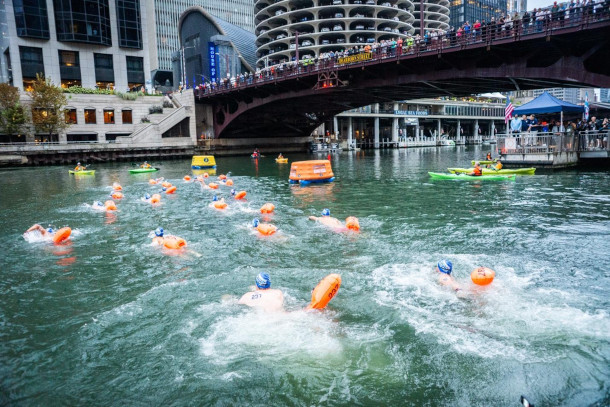
265 athletes swam in the main stem of the Chicago River during the public swim event in 2025. (Photo: Linda Barrett)
On September 21st, hundreds of people leapt into the Chicago River for the first public swimming event since 1927. Friends of the Chicago River Executive Director Margaret Frisbie joined Living on Earth’s Aynsley O’Neill to discuss how major projects including green infrastructure have helped clean up the river for both people and wildlife to enjoy.
Transcript
CURWOOD: On September 21, hundreds of people put on their bathing suits and leapt into the Chicago River for the first public swimming event since 1927. Famous for being tinted green on St. Patrick’s Day, the Chicago River has joined the ranks of the Seine and other iconic urban waterways that have been restored to some semblance of health. Thanks to a multi-billion-dollar tunnel and reservoir project, swamp restoration and other green infrastructure, it is not only safe for people, many species of fish and other wildlife have also returned. Friends of the Chicago River Executive Director Margaret Frisbie joined Living on Earth’s Aynsley O’Neill.
O'NEILL: This public swimming event was a fundraiser, but its impact actually goes even further than that. What does it mean to you to have public swimming in the Chicago River for the first time in nearly 100 years?
FRISBIE: You know, it was a magical day that's hard to describe, seeing hundreds of people in the water swimming so joyfully, really represented all the work that Friends of the Chicago River and so many organizations and agencies have done to improve the health of the river, not only for people, but for wildlife too. The morning of the swim, people just were beyond thrilled. People were watching from the bridges. They were watching from the Riverwalk. We had incredible media; there was 3 billion media hits. So literally, the whole entire world saw this happen. And for Chicago, what it represents, for people who've lived here a long time, I think it's a game-changer. Seeing people in the water makes you believe that it's possible, and because we have this reputation of being polluted, it's hard to penetrate and get those positive messages out there. And so this is emblematic, literally, of how clean the river is.
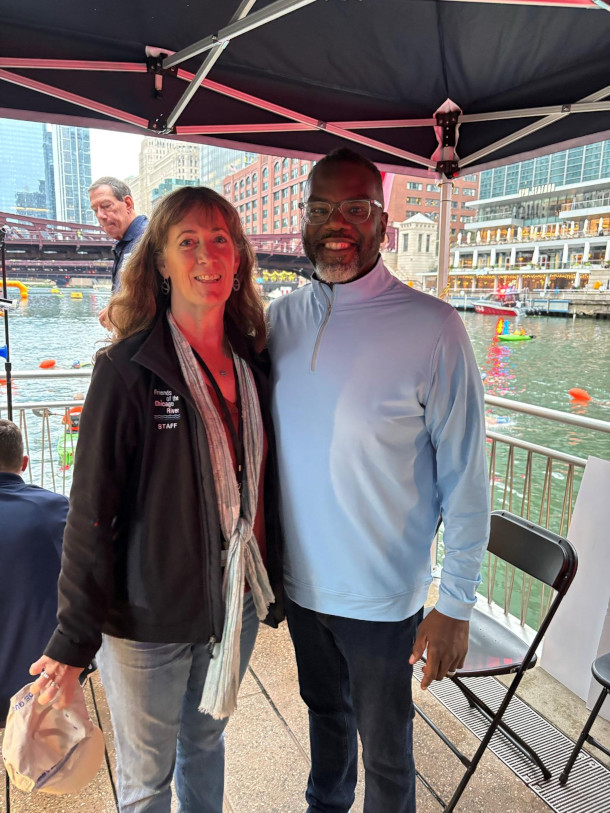
Friends of the Chicago River executive director Margaret Frisbie (left) with Chicago Mayor Brandon Johnson at the Chicago River Swim on September 21, 2025. (Photo: Courtesy of Margaret Frisbie)
O'NEILL: Yeah, well, tell us about who came to swim there.
FRISBIE: It was so exciting to see who was in the Chicago River for the Chicago River swim. We had Olympic athletes. We had local people. People are getting out of the water saying it was earthy, it was beautiful. It was clean, it was clear. In fact, Becca Mann, who's an Olympic athlete who swims 10Ks in open water, which is really impressive and amazing. She got out and she was just beside herself, and she said, I cannot wait to come back to Chicago and do this again. When you see an Olympic athlete swimming with joy in her heart, you know that this is a river that you're going to enjoy one day like that yourself.
O'NEILL: Well give us a sense of the difference between maybe now and maybe 50 years ago in terms of sewage spills into the river.
FRISBIE: So, when friends of the Chicago River was founded in 1979, on average, there was sewage in the river every three days. Fast Forward 46 years, and basically there's never sewage in the river ever. So having a swim like this is really completely possible every single day of the year. We just have to work on all the other safety protocols to make it okay.
O'NEILL: Margaret tell us a little bit about the ecosystem of the Chicago River.
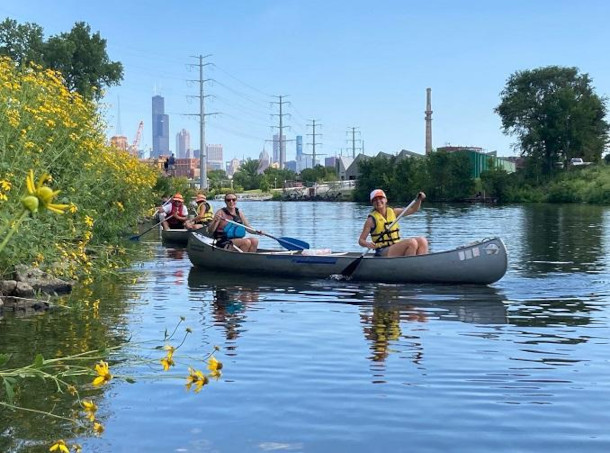
Friends of the Chicago River volunteers paddle in canoes on Bubbly Creek, picking up trash in 2022. (Photo: Friends of the Chicago River)
FRISBIE: The one thing that's always fun for us to talk about at Friends of the Chicago River is how alive the river is and how different it is. So the World Wildlife Fund has done studies around the world about the decline of biodiversity. And in fact, in the Chicago area, we're seeing our aquatic animal life going up, and that's because of the work of Friends of the Chicago River, the Metropolitan Water Reclamation District, the forest preserves at Cook County and so many partners. And so in the 1970s, when friends was founded, there were less than 10 species of fish in the river system. Now there's nearly 80, and we have beavers and muskrats and turtles, and we're seeing the return of river otters, who are really an excellent sign of river health, because they depend on clean water to keep their coats clean and their bodies healthy, and then they're also dependent upon mussels and fish and other aquatic and macro invertebrates to eat. And so it really is a really terrific sign of how far our river has come from those dark days when there was sewage in the water, on average every three days.
O'NEILL: For those who are unfamiliar, how did we get here? How did we get from a river that couldn't be swum into a river that had this massive swimming fundraiser?
FRISBIE: So 125 years ago, the City of Chicago and our sewage agency actually reversed the Chicago River away from Lake Michigan and designed it into our sewer system. So over the last 50 years, Friends of the Chicago River has been chipping away at both the actual water quality through advocating for cleaning up the river system, but also by using the Clean Water Act and building support for a river that was swimmable. And so the water quality has changed since 1979 when we were founded, bit by bit, you know, using the rules of the Clean Water Act and partnering with government agencies like the Metropolitan Water Reclamation District that dug a huge tunnel and reservoir system that's virtually eliminated sewage from the river system, and then also disinfecting sewage affluent that goes to the river, and just also creating public access so people can get down to and in the water.
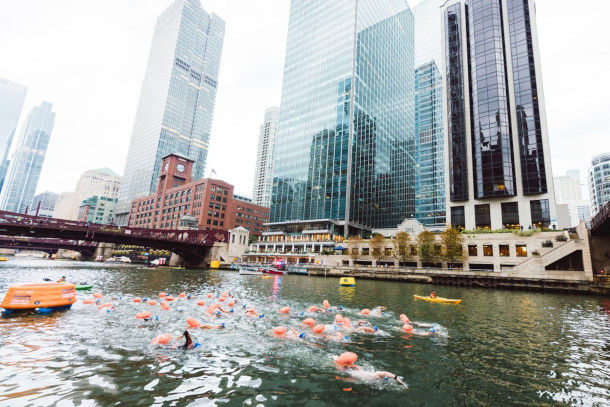
Swimmers race in the Chicago River in an event to raise money for ALS research. The next Chicago River public swim is scheduled for Sept. 20, 2026. (Photo: Chris Costoso)
O'NEILL: And so when we talk about cleaning the Chicago River, we were talking about using the Clean Water Act. What actual steps were being taken, how much of this was from a government level versus, you know, a volunteer level? How did that work?
FRISBIE: You know, it's a terrific question, and really it takes both. So the Tunnel and Reservoir Plan is 110 miles of tunnel, three enormous reservoirs that can store 17 billion gallons of sewage and storm water and industrial waste, right? However, it's not just about building it; it's having support for having that system and also making sure that the government agencies who are working on it are on task, and making sure that they're getting the work done. So when the project started in the 1970s, they thought it would be done in the mid 1980s and of course, a $3.2 billion project is going to take a lot longer than that, and they're going to need federal funding. So that's government support, but advocates encouraged and pushed a long ways. So while we partner with this agency, the Metropolitan Water Reclamation District, on many, many programs, we also were engaged with forcing a permit that included an enforceable deadline of 2029 so they have to be done and wrap up the project and not say, hey, we ran out of money, we just can't finish it yet. So it really is that partnership between the advocates like ourselves, representing the people who live here, and then the dedicated scientists and engineers who came up with this big idea. And then, of course, we're also working on green infrastructure to keep storm water out of the system, which also helps eliminate combined sewer overflows.
O'NEILL: What would you consider the biggest challenge during this process of cleaning up the Chicago River?
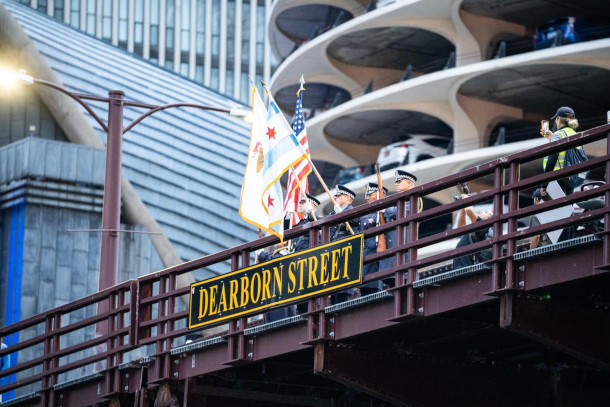
Festivities at the Dearborn Street bridge during the Chicago River’s first public swim in nearly 100 years. (Photo: Linda Barrett)
FRISBIE: So, you know, Chicago is interesting because, like many cities around the world, we have these combined sewer systems, right? And so people got used to the river systems being a place where sewage and waste could go, as opposed to we're on the shores of Lake Michigan, which everyone fights for and has been caring about for, literally, since Chicago started. So there's a cultural disconnect between our working river and our natural assets, when, in fact, the Chicago River is alive with fish and turtles and muskrats and beavers and all this wildlife. And we have to think about that as a living natural resource versus just this functional waterway, or even once it's cleaned up, one that's a water feature versus a river system.
O'NEILL: So, you know, some people might say, oh, well, you know, the ecosystem's been doing fine for all these years, and we've got beaches anyway. So you know, why is it so important to have a clean Chicago River? What would you say to that?
FRISBIE: There are a number of components to that. First and foremost, the river comes to us. It flows through communities. It's a community connector, and it provides access to nature for people who live in an urban area. We also know that with the impact of the climate crisis, heat is the number one killer, and it is incumbent upon all of us to take seriously the fact that people need public open space where they can go and they can get away from the heat, they can get away from the city. We also know natural areas, so the river and open space and natural areas along it can capture particulate air pollution. We know that nature actually improves public health, and, you know, mental wellness. So it plays so many, many, many roles. And then also we have major biodiversity loss, and cities can play a role in protecting biodiversity. And the Chicago River system is on the Mississippi flyway, so we are getting massive amounts of migratory animals, birds, bats, insects, and they depend on natural areas, and so it's really important for that too.

Friends of the Chicago River executive director Margaret Frisbie. On September 10, Friends of the Chicago River was awarded the Thiess International River Prize from the International River Foundation in recognition of the group’s extraordinary work to restore and revitalize the Chicago-Calumet River system. (Photo: Margaret Frisbie)
O'NEILL: Pollution and sanitation aren't the only things affecting our waterways. To what extent is climate change making an impact on the Chicago River?
FRISBIE: So locally, our climate impact includes heavier, more isolated rain showers. So we've built this big tunnel and reservoir plan infrastructure, but the way that the system was designed, it really wasn't to accommodate that kind of heavy rain. So in certain areas, even when the system can capture the volume, you can still get a combined sewer overflow, and the fact is that ends up sewage the river, which is bad for people in wildlife, but it also washes road salt and fertilizers and other pollutants into the waterway. And so we have to really be careful about where our rain falls, so that we absorb it into the ground and it doesn't end up in the river.
O'NEILL: For many of us, we might hear about the Chicago River once a year, St. Patrick's Day, when it gets dyed green. What do you think about this tradition in the context of all the work that's been done to clean up this river for wildlife and for the people?
FRISBIE: So at Friends of the Chicago River, we think that we have outgrown that tradition. It's really a fun morning. It builds community. People come out, they're so happy, but the river's evolved, and we think the tradition can evolve. And so we could come up with new ideas, you know, big, giant green shamrocks that melt away into nothing, or, you know, just, there's a host of ways to come up that you can still build that joy. But we think, you know, a river that's alive with wildlife really needs to be treated like a natural resource, not, you know, a candy-colored green toy that we can play with. And so we're hopeful that we'll evolve in Chicago. And I think if people imagined and understood that, say, a beaver swimming downtown through that green dye, they might rethink it and think, oh, maybe it's time to stop this and think about something else.
CURWOOD: Margaret Frisbie, Executive Director of Friends of the Chicago River, speaking with Living on Earth’s Aynsley O’Neill. And if you missed this first big swim in the Chicago River, you could mark your calendars for next year’s big public swim.
That’s September 20, 2026.
Links
Visit the Friends of the Chicago River website
Chicago’s Tunnel and Reservoir Plan
WBUR | “Swimmers Race in the Chicago River for the First Time in Nearly 100 Years”
Living on Earth wants to hear from you!
Living on Earth
62 Calef Highway, Suite 212
Lee, NH 03861
Telephone: 617-287-4121
E-mail: comments@loe.org
Newsletter [Click here]
Donate to Living on Earth!
Living on Earth is an independent media program and relies entirely on contributions from listeners and institutions supporting public service. Please donate now to preserve an independent environmental voice.
NewsletterLiving on Earth offers a weekly delivery of the show's rundown to your mailbox. Sign up for our newsletter today!
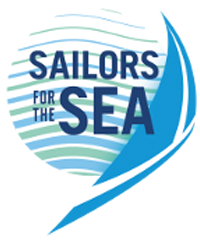 Sailors For The Sea: Be the change you want to sea.
Sailors For The Sea: Be the change you want to sea.
 The Grantham Foundation for the Protection of the Environment: Committed to protecting and improving the health of the global environment.
The Grantham Foundation for the Protection of the Environment: Committed to protecting and improving the health of the global environment.
 Contribute to Living on Earth and receive, as our gift to you, an archival print of one of Mark Seth Lender's extraordinary wildlife photographs. Follow the link to see Mark's current collection of photographs.
Contribute to Living on Earth and receive, as our gift to you, an archival print of one of Mark Seth Lender's extraordinary wildlife photographs. Follow the link to see Mark's current collection of photographs.
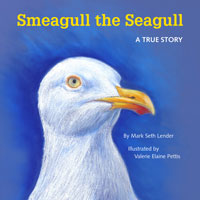 Buy a signed copy of Mark Seth Lender's book Smeagull the Seagull & support Living on Earth
Buy a signed copy of Mark Seth Lender's book Smeagull the Seagull & support Living on Earth

